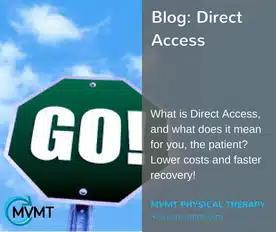Direct Access – What It Is, and What It Means For You

Direct Access is legislature in different states that allows patients quick access to medical professionals. Prior to Direct Access, MD’s were the gatekeepers of healthcare, and often became the bottleneck to treatment. After all, they can only see so many patients a day. The traditional model of handling low back pain required the Primary Care Physician (PCP) to recommend two weeks of rest and/or medication. After a follow-up, the patient may then be sent for imaging. That would then require the patient to make further appointments for an xray or MRI, then spend time, in pain, waiting for the follow-up. The patient may then, in some cases, be referred to a Specialist, with possible further imaging, before finally being referred to Physical Therapy. Consider the following scenario:

The days on the timeline are approximate, but quite common. Total wait time from onset of pain to starting treatment: ?? days. That’s a lot of time to be in pain. How many of those days do you have to call out from work? That’s a significant loss of productivity in the US, and it has been measured: about $635 billion per year. That’s billion with a “B” – lost productivity in the US from musculoskeletal pain.
How do we decrease that impact? One of the solutions is speeding access to the correct medical professional. Already have a good physical therapist in your Contacts? (If you’re reading my blog, you just might!) Here in New York State, you may visit a PT for either 10 visits or 30 days (whichever comes first) without a prescription. Consider this scenario:

So if you wake with musculoskeletal pain, you may actually be able to visit your PT that day (or their earliest convenience) and start feeling better immediately. And overall, research is showing that the overall cost of that episode of care will be less, if you don’t require advanced imaging first. Further, research shows that early access to physical therapy may lead to lower use of pharmaceuticals, fewer overall visits, and higher levels of outcome satisfaction. Direct Access laws vary by state, so you may need to do some research to see what is available to you. You may also contact your trusted PT directly – they should be able to quickly inform you of the state regulations.
But this is a reactionary measure. How else can we decrease any of these numbers: cost, wait time, length of care? In a word: Prevention. Granted, nothing can absolutely prevent injury. But with movement assessment and annual physical movement screens (check out our previous blog posting), we can start to identify when a body is at risk of injury.
We can also have a healthy diet of movement. There’s so much discussion about our diets – but there’s very little talk of our daily movement. But more on that, coming up…
Let’s get moving!
